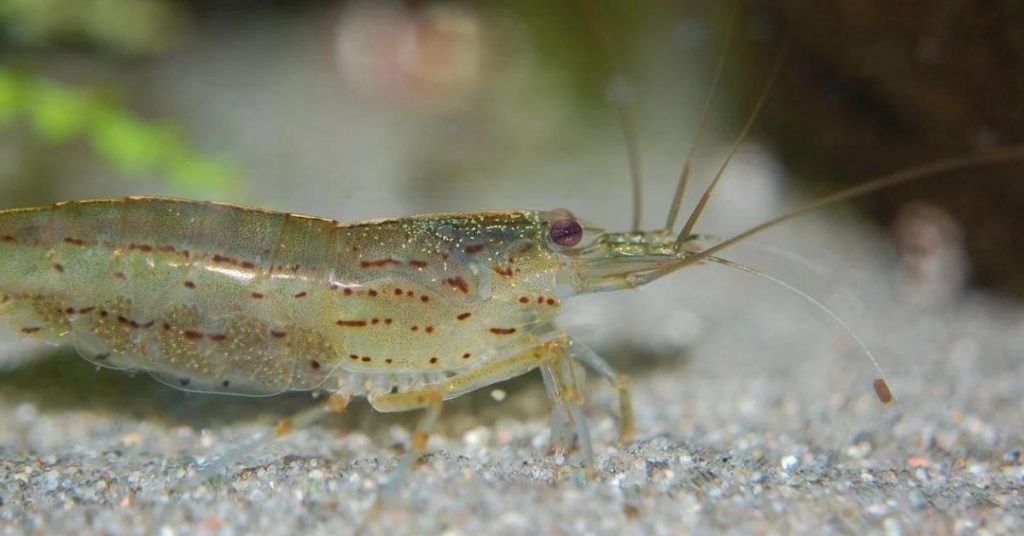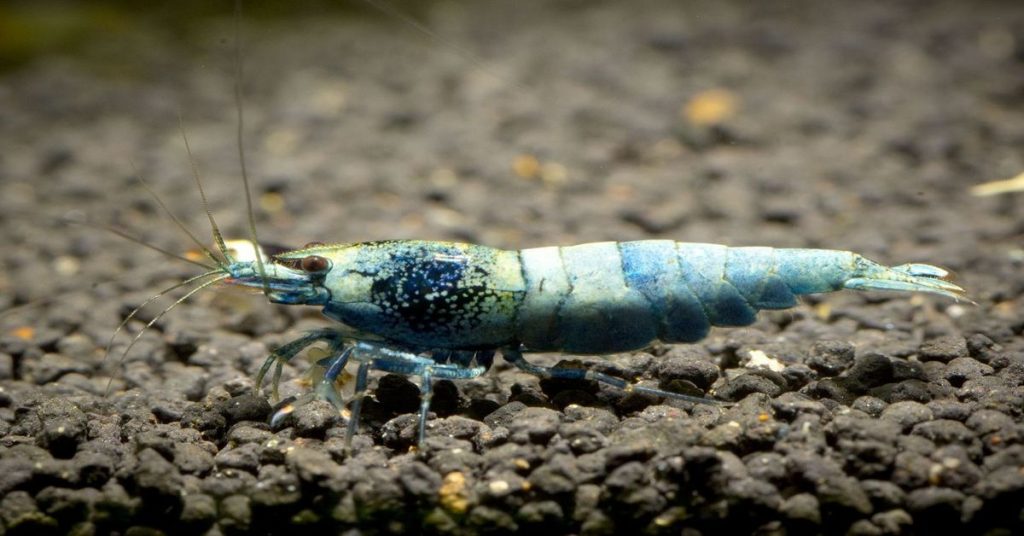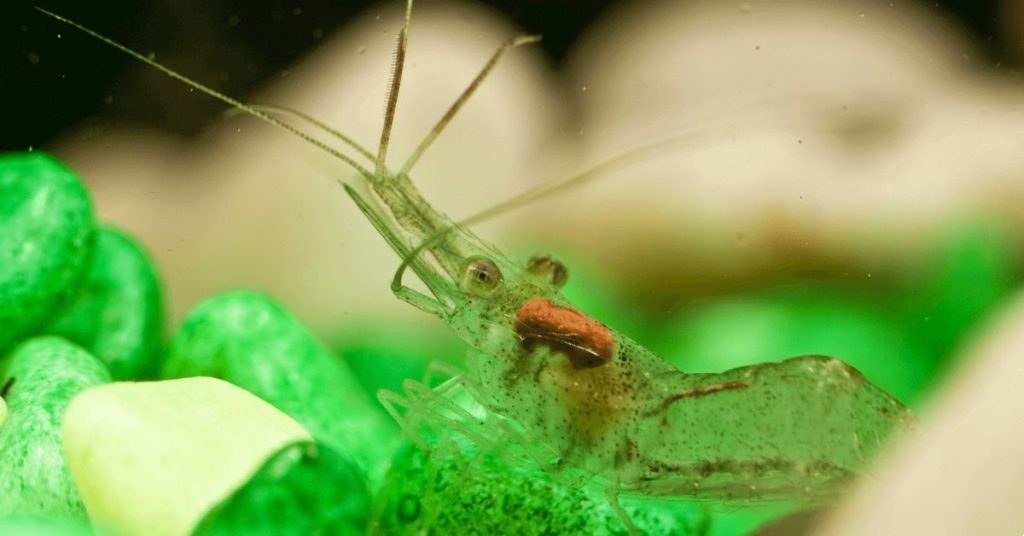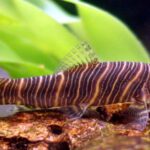Go virtually anywhere on planet earth, and these crustaceans will be waiting for you. They’ve populated every continent except Antarctica and can be found in brackish backwaters to the open ocean seabed alike.
They belong to the order Decapoda (Greek for ten-footed, many have more than ten), which shrimp share with their similar arthropod cousins. Yabbies, lobsters, crayfish, prawns, and crabs, along with shrimp, make up this colossal order that includes over 15,000 species.
Narrow that down to just the true shrimp that live in freshwater (versus brackish or saline), and you still have 750-odd viable options. Some are quite rare or have isolated habitats that aren’t conducive to fish-keepers, while others are very plentiful and kept by hobbyists throughout the world.
Today we’ll look at a few dozen of the most popular freshwater shrimp species and variants. Many are simply variants or breeds artificially selected for their most attractive traits, usually color.
Not every member is created equally, so let us see how these jumbo shrimp measure up.
1. African Giant Shrimp (Atya gabonensis)
Let’s start with the African Giant Shrimp, which like other shrimp species, has dozen of common and local names.

Vendors will often call them by their locally known or common names, of which there are dozens: African fan shrimp, African filter shrimp, African giant shrimp, Blue rhino shrimp, Cameroon fan shrimp, Gabon shrimp, and vampire shrimp, to name only a few.
They are all the same species and are very popular in the aquarium trade. They are sought after as both prolific cleaners and as colorful showpieces.
Just know they may change appearance after each molt. With each molt (or change of coat) comes with a different-colored costume change in tow.
Keeping an African Giant Shrimp has only two primary headaches: breeding and feeding. They have proven impossible to breed in captivity and can be difficult sometimes to satiate. However, despite their label as vampires, they actually prefer carrion and plant matter over blood.
Remember that shrimp, in general, tend to be heavy feeders, and this (three-inch) giant expects food to regularly come floating by in the currents as it would in nature. You’ll need to simulate this by providing a similar current in your own tank.
Size: 3 inches
Difficulty: Intermediate
Minimum Tank Size: 20 gallons
Temperature: 75° – 85° F / (24° – 29° C)
2. Amano Shrimp (Caridina multidentata)
Like their giant African counterparts, these also do not breed well in captivity. In fact, they do not adapt well to any significant changes in their environment.

Since most are wild-caught for the aquarium trade, you need to temper the water cautiously to replicate their natural habitat.
This means replicating the temperature, relative salinity, and habitat current. Not only the habitat of their native home but that of the pet store or vendor.
In addition to getting the water, you need to ensure they have both a sandy to a small granular substrate and a wide variety of marine plants to explore or graze for micro-organisms.
Once they acclimatize to their new home, they are virtually carefree. Indeed, Amano Shrimp are not only attractive arthropods, but they also earn their keep by virtue of all the housekeeping duties they perform over the next five years.
So, plan on having them as neighbors for a lot longer than most shrimp.
Like many other freshwater shrimp, this one has several other common or local names. They might be listed as Caridina Japonica (archaic), the Japonica Shrimp, the Algae Eating Shrimp, or even Yamato Shrimp.
Size: 2 inches
Difficulty: Intermediate
Minimum Tank Size: 20 gallons
Temperature: 70° – 80° F / (21° – 27° C)
3. Bamboo Shrimp (Atyopsis moluccensis)
Bamboo shrimp have similar sensitivity to water parameters and can be difficult to acclimate. After that, they’ll put on their construction hats and get to work continuously for the rest of their lives.

While this sounds overly dramatic, it is the literal truth. They are amongst the busiest, most active, and enterprising scavengers you’ll choose for your aquarium.
Although most decapods are heavy-armored, slow-moving beasts, Bamboo Shrimp, sometimes also known as the Wood Shrimp, may help break the stereotype. Rather than simply waiting for food to float by in the current (a common crustacean feeding strategy), they will actively seek out their next meal.
They are certainly not ambushed predators but highly opportunistic omnivores that will clean the dinner plate and your tank every time. Their appendages have fan-like growth that can be used like fishing nets to assist with foraging.
This is how they got their other common name, the Fan Shrimp.
Size: 3 inches
Difficulty: Intermediate
Minimum Tank Size: 20 gallons
Temperature: 70° – 80° F / (21° – 27° C)
4. Bee Shrimp (Caridina cantonensis)
Although not a true pygmy variant, its bee-like size gave rise to its common name. This tiny crustacean calls Taiwan home in the wild but has now seen distribution throughout aquariums of the world.

However, they are recommended for intermediate to advanced hobbyists since they are even pickier about their water conditions. Firstly, they like it chilly – not Atlantic lobster (Homarus Americanus) in the grey, dark, Atlantic cold, but still possibly chilly for nearby shrimp neighbors.
Secondly, they prefer mildly acidic water conditions that should not vary in pH, temperature, or flow rate.
They are pretty particular about where they call home. Once they’ve found it, they’ll primarily self-manage and steer clear of anything more significant for fear of being eaten.
Size: 1 inch
Difficulty: Intermediate
Minimum Tank Size: 10 gallons
Temperature: 68° – 74° F / (20° – 23° C)
5. Black (or Green) Midget Shrimp (Caridina babualti)
They are a dwarf species of shrimp commonly called midgets and usually identified by color. Black and Green are the most popular colors, but variants have been found even in elusive blue and zebra stripes.

While the latter two colors are rare, Cardina babualti are generally easy to find worldwide at very reasonable prices. This, along with less rigorous water demands, makes it a perfect entry-level freshwater shrimp for the beginner.
Although they prefer water similar to their natural habitat in the tropics of the Indian subcontinent, they adapt more readily to sub-optimal conditions. If you keep clean water gently flowing in their tank at a steady temperature, they will quickly make themselves at home.
Size: 1.5 inches
Difficulty: Beginner
Minimum Tank Size: 10 gallons
Temperature: 64.5° – 82.5° F / (20° – 28° C)
6. Blue Bolt Shrimp (Caridina Catonensis var. blue bolt)
Blue Bolt Shrimp are the blue polymorphs of C. Cantonesis and voraciously sought after by shrimp masters for their bright blue coats.

Much like an American blue lobster or all-black Eastern Grey Squirrels (Sciurus carolinensis), they are the same animals with different colored exteriors but precisely the same species.
What has changed in them is a gene affecting their shell or coat coloration. Sometimes this is a purposeful evolutionary adaptation (black coats absorb sunlight in the northern range of the squirrels), while at other times, it is an accidental gene mutation like when we find random blue lobsters in the deep.
Regardless of their color, this blue bee shrimp has the same water parameters and care needs as their normally-hued siblings. They are pretty needy, require companions of their own kind, and impeccable water conditions.
This makes them a risky bet for beginners as premium showpieces sometimes sell for several hundred dollars each.
Size: 1.25 inches
Difficulty: Intermediate
Minimum Tank Size: 10 gallons
Temperature: 68° – 74° F / (20° – 23° C)
7. Blue Pearl Shrimp (Neocaridina zhangjiajiensis)
Also known as Snowball Shrimp, the Blue Pearl can be just as brilliantly blue as the Blue Bolt but without all of the headaches. They adapt to water temperature, pH, and other parameters regularly and eat, well, everything.

By choosing a Blue Pearl Shrimp for your tank, you’ll get a brilliant blue mate that is not only easy to keep but easy to breed. In fact, they will require neither encouragement to reproduce nor any specialized environmental changes.
Most clutches (the correct term for a group of baby shrimp) require some salinity to mature. This may stem from freshwater shrimp heading out to brackish mangrove shallows near estuaries to breed in their natural habitat.
Not the Blue Pearl; they’ve adapted to skip the migratory mating routine and can get down to business without switching the environment around them. So if you really want to dive deep into animal husbandry and shrimp wrangling, this is a low-risk opportunity for newcomers.
Size: 1 inch
Difficulty: Beginner
Minimum Tank Size: 20 gallons
Temperature: 70° – 80° F / (21° – 27° C)
8. Blue Tiger Shrimp (Caridina cantonensis var. blue)
The classification of the Blue Tiger Shrimp is still up for scientific debate. Although believed to be another color polymorph, there may be physiological differences between now identified variants that could make them unique species.

It just shows you how difficult it can be to sort out the results of artificial versus natural gene selections. That said, they still are a popular aquarium choice despite their difficulties with taxonomy and care needs.
People choose them for the color and tiger-like striped patterns. However, they don’t realize that because of the intensity of their breeding, they may be prone to illness and can’t quickly adapt to large volume water changes or parameters.
They’re amongst the most expensive and demanding shrimp you’ll get. With that thought comes an unrivaled indigo-blue shimmer. Just don’t plunk them in with other Caridina, as they may quickly hybridize back to the base model.
Size: 1 inch
Difficulty: Advanced
Minimum Tank Size: 10 gallons
Temperature: 64.5° – 75° F / (20° – 24° C)
9. Blue Velvet Shrimp (Neocaridina davidi var. blue)
Rounding out the blues brothers are Blue Velvet Shrimp. They also can be called Blue shrimp, Blue Dream Shrimp, Blue Cherry Shrimp, Blue Dwarf Shrimp, Velvet Blue Shrimp, or Blue Jelly Shrimp, depending on where you live in the world.

If you’re not confused enough already, the Neocaridina davidi, often known as the Cherry Shrimp, is all one and the same creature. This particular variant has blue coloration, adding them to the already long list of rare, blue, sought-after aquarium guests.
This coloration does not often occur in nature, so if you see Blue Velvet Shrimp for sale, you can be assured that they were human-reared. Once acclimatized to their water conditions, they are resilient but benefit most from living in warm water conditions, which helps to preserve their colors.
Size: 1 inch
Difficulty: Beginner
Minimum Tank Size: 10 gallons
Temperature: 70° – 80° F / (21° – 27° C)
10. Crystal Shrimp (Caridina cantonensis var. Crystal Red)
Crystal Shrimp is the red polymorph of the Bee Shrimp. So care, consideration, and complexity of needs for Crystal shrimp is precisely the same.

What sets them apart is their color; they aren’t just red, but rather koi-like. Most have solid snow-white bodies and heads with red bands and spots along the abdomen and carapace.
However, the degree of sophistication of each variant is complex.
They have even been given gradients based on their degree of color transformation. This is much like how produce is graded for quality throughout the world.
Size: 1.5 inch
Difficulty: Intermediate
Minimum Tank Size: 10 gallons
Temperature: 68° – 74° F / (20° – 23° C)
11. Ghost Shrimp (various species in the genus Palaemonetes)
There are 30 known species within the genus Palaemonetes, of which many are loosely referred to as Glass Shrimp. While some pet stores or vendors may also advertise them as ghost shrimp, they really could be any number of species.

This includes fresh water and saltwater shrimp varieties, specimens large and small with varying degrees of longevity. You’ll want to get clarification and a positive species identification before committing to purchase the correct one from a myriad of possibilities.
Size: 0.5-10 inches
Difficulty: Various
Minimum Tank Size: 10-20 gallons
Temperature: Varies by species
12. Glass Shrimp aka Feeder Shrimp (Palaemonetes paludosus)
The most familiar members of Palaemonetes you will encounter are Glass Shrimp. It can be labeled as a kind of ghost shrimp or eastern grass shrimp but is a specific species within among true (caridean) shrimp.

This one is native to the southern reaches of North America and extensively bred as live food for other fish, which explains why they can also be called feeder shrimp. This Implicitly means they are easy to breed, require little care and grow relatively quickly.
It also means that if you choose a Glass Shrimp for your tank, it should not live beside other feeders.
Goldfish, plecos, angelfish, gouramis, danios, and many others will gladly have them over for dinner at no charge.
It is perhaps poetic justice that the Glass Shrimp will also predate many of their juveniles if given a chance. Glass Shrimp are easy to raise but don’t always make good neighbors.
These still are truly fascinating shrimp with completely translucent bodies. This means you can see the internal organs in action, making them a hit with all, but especially with small children.
They’ll get a proper inside look at their pets and gain insight into their own bodies just from the viewing experience.
A final word on breeding, they breed prolifically and without much aid. So if you live in their natural range, there is no need to collect your stock from the wild.
Parasites can come along with them to their new home introducing pathogens and other trouble to an otherwise healthy population and aquarium.
Size: 1.5 inches
Difficulty: Beginner
Minimum Tank Size: 10 gallons
Temperature: 64.5° – 82.5° F / (20° – 28° C)
13. Indian Whisker Shrimp (Macrobrachium lamarrei)
The Indian Whisker Shrimp or Kuncho River Prawn might be the most aggressive shrimp around. Regardless of size-mismatch or being out-gunned, this shrimp fights well outside its weight class.

They have adopted an opportunistic feeding lifestyle that drives them to eat just about anything. Indian Whisker Shrimp are highly territorial, aggressive, and even cannibalistic. Small bottom-feeding fish or other juveniles won’t stand a chance.
If you are looking for a little raw nature and a new career as a tank referee, these can be very interesting to own. Just be forewarned they can be schoolyard bullies.
Size: 2.5 inches
Difficulty: Intermediate (on temperament alone)
Minimum Tank Size: 10 gallons
Temperature: 75° – 85° F / (24° – 28° C)
14. Pinocchio Shrimp (Caridina gracilirostris)
While many of the previously mentioned shrimp species originated in very precise locals, this shrimp has been found throughout the entire Old World, including many far-flung islands.

Their dispersion increased with their popularity in the aquarium trade as rather large, curious, red-nosed shrimp.
If Rudolph had a long-lost crustacean cousin, the red front shrimp, red rhinoceros shrimp, red-nosed phantom shrimp, or Pinnochio Shrimp could well be the missing link.
This semi-transparent, red and yellow striped shrimp is mainly known for its long red rostrum (a beak or nose-like). They are very active and territorial but nowhere near the severity of the Indian Whisker Shrimp.
Size: 4.5 inches
Difficulty: Intermediate (setup and maintenance)
Minimum Tank Size: 10 gallons
Temperature:75° – 85° F / (24° – 28° C)
15. Pinto Shrimp (Caridina Catonensis var. Pinto)
As you can probably tell from its Latin name, the Pinto shrimp is a Bee Shrimp with pinto coloration or light and dark intermittent patterns like spots on a leopard or stripes on a zebra.

There are also countless common names for individual Pinto Shrimp colors and patterns. They range from zebra pinto, pinto cloud, pinto tiger stripe, and beyond.
This includes every conceivable design you could possibly paint on a Bee Shrimp. Much like a snowflake, they are infinite variations to their color, and as a result, Pinto Shrimp prove very popular choices.
Size: 1 inch
Difficulty: Intermediate
Minimum Tank Size: 10 gallons
Temperature: 68° – 74° F / (20° – 23° C)
16. Red Cherry Shrimp (Neocaridina davidi var. red)
As the name suggests, it is a Cherry shrimp (N. Davidi) but with an extreme red color morph. Like other proprietary-colored shrimp, they can fetch incredible prices at the highest grades. The more powerful the red, the higher the value.

Given the cost of some specimens, it is essential to remember that they are prey for all larger flesh-eating fish in nature. In your aquarium, they should only be housed with very docile herbivores to protect your investments.
Size: 1 inch
Difficulty: Beginner
Minimum Tank Size: 10 gallons
Temperature: 70° – 80° F / (21° – 27° C)
17. Red Rili Shrimp (Neocaridina davidi var. rili)
Red Rili is actually a sub-breed of Red Cherry Shrimp. They are selectively bred for bright red coloration and translucent patches giving them a completely unique look.

Their care, temperament, and setup of living conditions are the same for all species members. Their cost is similar to other proprietary blends, whereby a high degree of breed optimization always fetches the premium.
Size: 1 inch
Difficulty: Beginner
Minimum Tank Size: 10 gallons
Temperature: 70° – 80° F / (21° – 27° C)
18. Sunkist Shrimp (Caridina thambipillai)
We round out the collection with one final completely new species, the Sunkist Shrimp. While this seems like it might blend in with other color mutants and simply be an orange-colored variant, this one is actually its own species C. Thambipillai.

Native to peninsular Malaysia and adjacent countries, this shrimp might well be the best balance of all. They do have a tale-tell orange glow to them, but this is completely natural for the species.
It is neither a color morph (gene mutation) nor a bred-to-selection example of natural beauty.
They’re easy to care for and, although challenging to breed (they need those brackish mangrove-like conditions), make excellent bottom-dwelling community tank members.
Instead, they don’t predate but seek out micro-organisms from tankmates who are willing to tolerate their interactions.
If you think this might be the right choice for you, keep on the lookout for fish labeled: Borneo Orange Shrimp, Orange Shrimp, Orange Pumpkin Shrimp, Tangerine Shrimp but most commonly known as the Sunkist Shrimp.
They can be pricey and hard to find but well worth the investment given their beauty and ease of care.
Size: 1.5 inches
Difficulty: Beginner
Minimum Tank Size: 10 gallons
Temperature: 68° – 77° F / (20° – 25° C)
Final Thoughts
Shrimp are popular amongst aquarists for their benefits but they are not a one-size-fits-all crustacean. They do provide some tangible benefits for the community but need to be selected for the correct longevity, size, and purpose beyond appearances.
They’ll clean your tank and add dynamism to the biome. Depending on the species they might eat all of your undesirable algae and microbes or themselves be added to your fishes’ diet.
Some of them will take up long-term residency while others will be ‘just visiting’ or perhaps staying for supper.
Although many of them are stunningly beautiful, their main benefit is rounding out the artificial ecosystem you’ve built for them. They’ll be the head of your green team, cleaning up, and recycling waste materials as they go.
Just don’t go too crazy with the crustacean population as that might be overkill.


